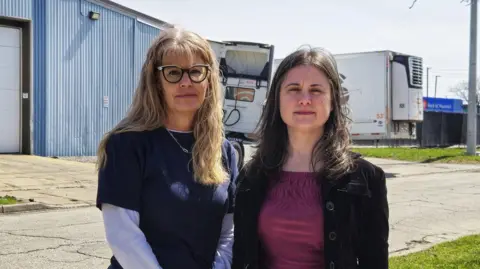In Windsor, Ontario, often regarded as the automobile capital of Canada, the local workforce is gearing up for uncertain times ahead. With a rich automotive heritage that includes generations of workers dedicated to companies like Ford and Stellantis, the region is experiencing trepidation over recent U.S. trade policies that threaten to disrupt their livelihoods. The situation has become particularly critical with the implementation of tariffs on vehicles and auto parts introduced by the United States, rattling the already fragile stability of the automotive industry.
Many residents of Windsor, including long-time automotive workers like Kathryn Lawton and her husband Chad, who are deeply rooted in the area’s automotive history, find themselves questioning the nature of their jobs. For over a century, the Lawton family has contributed to the thriving automotive workforce, a tradition that Kathryn describes as fifth-generation loyalty to Ford. When government officials such as former U.S. President Donald Trump accused Canada of ‘stealing’ American automotive jobs, Chad refuted these claims vehemently, asserting, “These were never American jobs. They were Canadian jobs.” He reinforced their pride in the industry, emphasizing that although they border the U.S., their contributions belong to Canada’s economy.
Windsor’s strategic location adjacent to Michigan places it in the crosshairs of trade tensions, especially as President Trump’s tariffs on foreign-made vehicles and components loom large. The 25% tariff on imported vehicles certainly casts a shadow over the operations of local businesses that rely heavily on a seamless cross-border supply chain. Moreover, there are fears of impending U.S. tariffs on auto parts, adding another layer to the anxiety felt by workers in the region.
Windsor’s automotive history is notable; it has evolved from being primarily linked to Ford since its establishment there in 1896 to housing multiple major manufacturers, including Stellantis, which started its operations in 1928. Over time, the economy has adapted amidst changing dynamics in auto manufacturing, yet with the loss of many manufacturing jobs, remnants of the city’s industrious past remain. Workers have devoted their lives to building well-known vehicles, grappling with the memories of prosperous times, while current fears of job loss and economic downturn mount.
The sentiment among the workers at Windsor’s auto plants echoes the uncertainty felt during previous economic downturns, such as the 2008 financial crisis, which led to substantial layoffs and bailouts for major automotive manufacturers in the U.S. “This feels the same,” reflects Chad Lawton, referring to key emotional responses among workers today. Anxiety prevails, magnified by the fact that the new tariffs could lead to significant impacts not only on direct auto jobs but also on the broader community reliant on these industries.
Local union leaders, such as John D’Agnolo from Unifor Local 200, express grave concerns for the future, predicting a recession if economic conditions do not improve soon. Echoing these apprehensions, restaurant owners like Van Niforos of The Penalty Box, a popular eatery frequented by auto workers, fear the consequences of a shrinking auto industry on their business viability. Without a doubt, a downturn could result in job losses for the 60 employees that his restaurant supports.
As the Canadian federal election approaches, the political ramifications of these tariffs become a focal point, with leaders like current Prime Minister Mark Carney strategizing plans aimed at bolstering the automotive sector. His commitment to establish a fund targeting job security and the manufacturing base reflects the urgency of the situation on the ground, while opponents propose various relief measures. The competition to address the economic challenges faced by Windsor’s workforce is palpable as the community wrestles with maintaining its automotive legacy amid unsettling geopolitical shake-ups.
Ultimately, the people of Windsor find themselves confronted with the precariousness of their economic future, shaped by external pressures and internal dynamics that intertwine the automotive industry with the community’s identity. As the tariffs loom and the election season unfolds, the fate of Windsor’s automotive heartland hangs in the balance, with its workers hoping for outcomes that will safeguard their proud heritage in the face of change.



